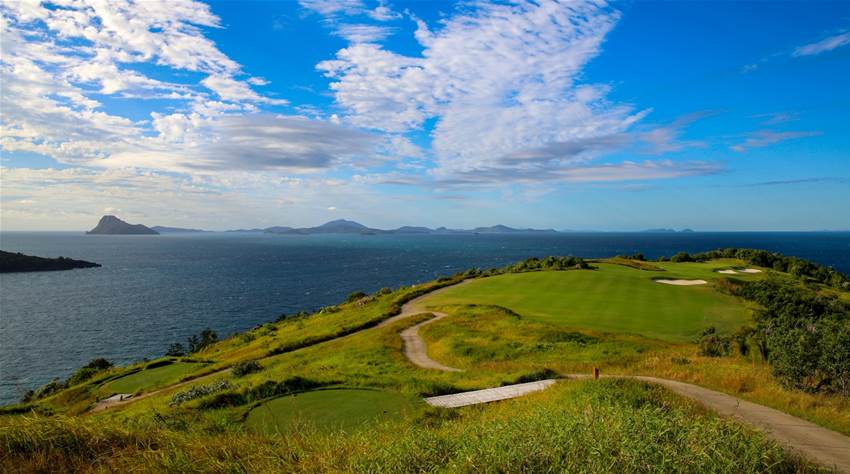The sun was just rising above the eastern horizon when I arrived at the Hamilton Island marina to get the ferry that would whisk me across the narrow passage to Dent Island for a morning of golf and then lunch at Hamilton Island Golf Club.
Yes, you read that correctly. Hamilton Island Golf Club is actually located 10 minutes away from the island of the same name on Dent Island – a tropical tree and scrub-covered monolith that rises steeply, to about 105 metres at its highest point, from the aquamarine waters of the Coral Sea below. Course co-designer Ross Perrett says the island used to be home to “little more than two goats and a lighthouse.”
As ‘The Island Links’ skimmed across the glassy waters of Dent Passage there were no hints a golf course was to be found on the ridges and cliff-tops towering above. This is not my first voyage across the passage, but you never tire of one of the best ways to start a day playing golf, especially on a calm, clear morning like I encountered. At this time of day, its only golfers being greeted by the friendly staff on the jetty, ready to shuttle them up the hill to the beautiful clubhouse. Then the real fun begins.
It is nearly 14 years since the first shots were played on the visually spectacular Hamilton Island course, and remains one of the great engineering and golf course design feats this country has seen, which explains, in part, why it took more than 25 years to come to fruition.
In the mid-1970s, the late Keith Williams purchased Hamilton Island and the original plan was to turn the island into a massive grazing property. But the visionary and tourism pioneer abandoned those plans and by 1982 he had gained Queensland government approval to begin development of a marina, commercial airport and multi-storey resort hotel.
As the popularity of Hamilton Island grew so did the need to expand its attraction offering to tourists. And Williams knew golf needed to be part of that plan.
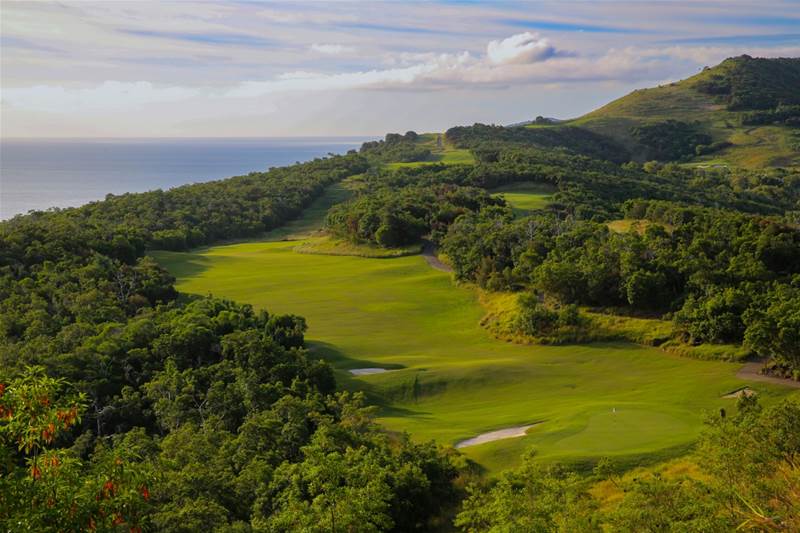 The 5th is a short par-5 that offers some scoring respite after the tough par-3 4th. PHOTO: Brendan James.
The 5th is a short par-5 that offers some scoring respite after the tough par-3 4th. PHOTO: Brendan James.But in the years that followed, logistics, cost and the politics of constructing a golf course on an island in the middle of the Great Barrier Reef Marine Park kept the proposal entrenched on the back-burner.
But the idea of a world class golf course re-emerged in 2003 when Hamilton Island was sold to renowned winemaker, yachtsman and philanthropist, Bob Oatley. Having sold his Rosemount Wines to Southcorp for $1 billion a year earlier, Oatley bought Hamilton Island for $200 million and over the next six years he invested a further $300 million into upgrading the resort isle.
Part of his investment also included working through all the red-tape that would ultimately lead to the construction of the Hamilton Island course designed by five-time Open Champion Peter Thomson and Perrett.
There were 24 environmental impact statements completed – covering vegetation, water, the reef, wildlife and birds – before any land was turned on the course.
“So, there was a lot of work before we started. The Hamilton Island people who got the permits to build did a hell of a job,” Perrett said. “Many people would have given up but Bob Oatley had the belief that it could be done. He was patient and willing to tick the boxes to get it done."
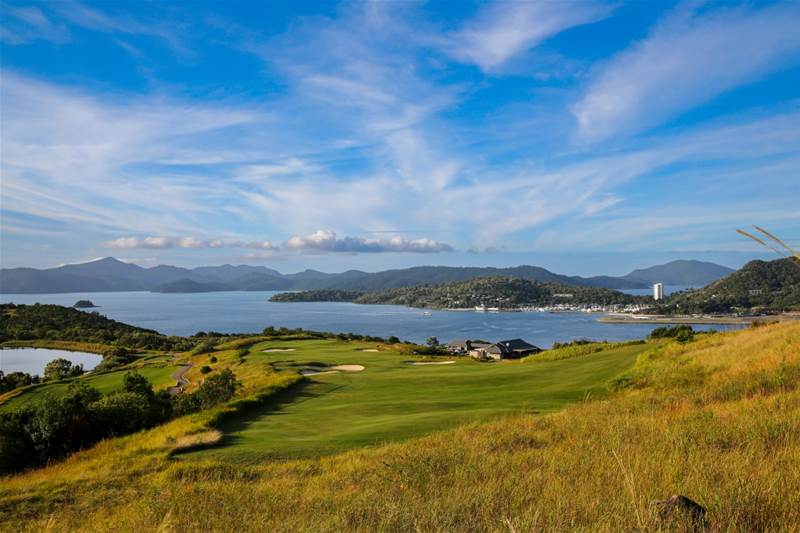 A view worth waiting for… The vista from the tee on the par-4 18th hole. PHOTO: Brendan James.
A view worth waiting for… The vista from the tee on the par-4 18th hole. PHOTO: Brendan James.Once a construction date was set the first hurdle was to get all the heavy machinery onto the island, which was no mean feat given the steep cliffs, rocky shorelines and coral reefs that surround the island.
“The landing (jetty) that is there now came after the course was finished,” Perrett said.
“The landing we had to bring all the equipment on was very tricky. So, all the machinery – the bulldozers and earth-moving trucks – had to be barged across from the mainland and had to come onto the island at high tide.
“It was a difficult exercise and we had to be very careful because there is a coral reef right around the island. It was quite amazing really.”
 There is absolutely no room for error on the long par-3 4th hole. PHOTO: Brendan James.
There is absolutely no room for error on the long par-3 4th hole. PHOTO: Brendan James.Then came the task of clearing scrub, shaping the land and finding 18 holes across the dramatic landscape.
“The holes were tough to find but we took our time,” Perrett said. “The first nine is in and around a valley and has a lake, which we raised about two metres, and that solved the water problem. The first four holes go out and then you loop back to finish the nine. The second nine was much more difficult to design.
“There’s a ‘razorback’ shaped ridge running south. The course runs out along the ridge but then there’s no way back, which is why there is a one-kilometre track between the 17th green and 18th tee. That also had its advantages because you get that beautiful view from the 18th tee to end the round.”
Building a golf course on an island was always going to be logistically tricky, and expensive. But Perrett said the construction and design team became very resourceful to keep the costs down. When it came to sand-capping the course the cost could have blown the building budget.
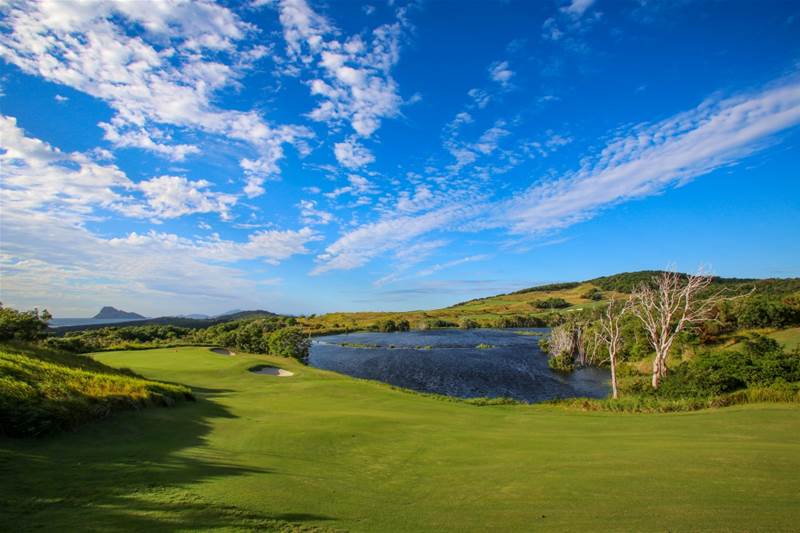 The shortest route to the green on the long par-4 9th is over the edge of the lake. PHOTO: Brendan James.
The shortest route to the green on the long par-4 9th is over the edge of the lake. PHOTO: Brendan James.“The cost to barge in sand from the mainland would have been prohibitive so we made our own sand on the island,” Perrett said. “There were seven crushing machines on the island, and we crushed our own sand. We didn’t waste anything. Rocks the size of Volkswagens were crushed into beautiful sand.”
Hundreds of tons of crushed rock were turned into sand forming the course’s foundations on which the Bermuda Tifeagle and couch playing surfaces would grow.
Then in August 2009, just days after Peter Thomson celebrated his 80th birthday, the first shots were struck on the layout that has since risen to become the No.13 ranked Public Access Course in Australia (Golf Australia magazine 2023) and one of the world’s most visually spectacular courses.
It takes only a few holes into the round to really appreciate what an incredible feat of engineering, course design and construction it was to realise in creating a layout across such dramatic and rugged terrain.
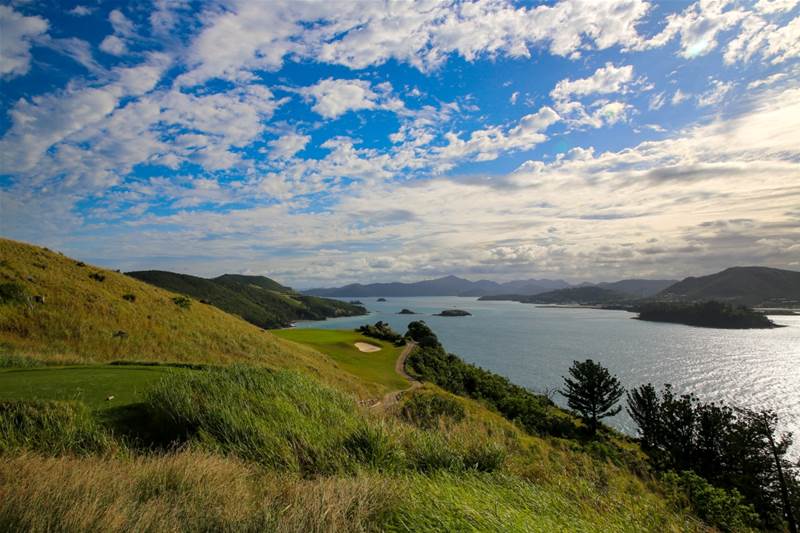 The green on the downhill par-3 16th is perched high above the dent passage. PHOTO: Brendan James.
The green on the downhill par-3 16th is perched high above the dent passage. PHOTO: Brendan James.Dent Island lies in the heart of The Whitsundays, which was a geologically active zone where volcanic activity continued for 37 million years. This meant hundreds of tons of basalt were carved from the landscape to facilitate the positioning of tees, greens and fairways. The result of all that activity is evident from the moment you step on the 1st tee, where there are massive basalt boulders to be seen everywhere.
Thomson and Perrett designed the par-71 to be played along a series of ridges and across steep valleys with only minimal clearing of the island’s dense native vegetation. The mountainous aspect of the design presents elevated tees on most holes, which not only leaves little to a golfer’s imagination of the hazards that lie between tee and green but they also offer stunning sea and island views in all directions.
At 6,140 metres from the back markers, this is not a long layout by modern standards and despite elevation changes on most holes and some narrow driving zones, the scoring here can be good on a still day. But windless days are rare across the top of Dent Island and the design team has taken that into account by offering generously wide fairways along with large, rolling greens.
As this is a resort course, there are three teeing grounds per hole with 30 or 40 metres difference between the back and middle tees. This ensures good players will be challenged by the back ‘Hoop Pine’ markers and casual players won’t be overawed by the experience by playing from either the middle ‘Pandanus’ or the front ‘Grass Tree’ tees.
The opening trio of holes – all cut into a ridge on the north side of the clubhouse – eases you into the round. Then it is most definitely ‘game on’ when you reach the par-3 4th. From the tips this absolute gem measures 175 metres and is played across a scrub-filled valley to a large, undulating green that is more exposed to the wind than any other hole on the front nine. The putting surface lies on a ridge where shots long and short-left are gone for good. Played against the backdrop of distant Long Island and the mainland, as well as being beautifully framed by rocky outcrops, this is a hell of good hole and must surely be among the best, if not the toughest, par-3s in the country.
That said, all four of the par-3s here are outstanding. Each demands different shots, clubs and strategies to equal par and poor shots are punished. The 160-metre par-3 16th is already developing a reputation as a destroyer of good scores. The tees and green have been cut out of the side of an escarpment, with the tee elevated high above the plateau putting surface, making the hole play much shorter than the scorecard suggests. This, for mine, is the most spectacular hole on the course and, perhaps, the most treacherous. The only bail out area here is just short of the green. The deep bunker cut into the front right edge of the green even looks good while standing on the tee. Miss the green right or long and you can drop another ball, while any tee shot drifting left will leave a tough chip from long grass.
The 16th hole lies at the heart of a finishing quintet of holes I would argue is the most stunning closing sequence of holes in Australia, which reaches its climax at the long par-4 18th. From the tips, it is a 421-metre journey but with the tee elevated high above the downhill slope of the fairway, this hole plays much shorter. The key here is to avoid the two big fairway bunkers hugging the left edge of the driving zone, and not hit too long as to find another big bunker 20 metres further on but to the right. Laying up short of these hazards will leave a mid-iron to a big green and a good chance of par.
Course superintendent Brad Hole – who has been weaving his greenkeeping magic across this layout since it was being constructed – and his team always presents the layout firm under foot, which was how it was designed to be played. This, for mine, adds to the overall golfing experience as you try and navigate the best playing lines and landing areas to keep the big scores off your card.
And then, when the round is done and you’re lapping up the cooling breeze on the clubhouse deck, spend some time to navigate the lunch menu. Instead of trying to decide between driver and 3-wood, the task is whether to go with the seared scallops or tempura oysters kilpatrick for entrée followed by the lamb rump. I made it easy for myself and spent two days playing Hamilton Island and had both entrees. Life’s short!
FACT FILE
 LOCATION: Dent Island, near Hamilton Island in the Whitsunday Passage.
LOCATION: Dent Island, near Hamilton Island in the Whitsunday Passage.
CONTACT: (07) 4948 9760.
WEBSITE: www.hamiltonislandgolfclub.com.au
DESIGNERS: Peter Thomson and Ross Perrett (2009).
PLAYING SURFACES: Bermuda TifEagle (greens), Greenlees Park couch (fairways, tees and rough)
COURSE SUPERINTENDENT: Brad Hole.
GREEN FEES: $165 (18 holes, including ferry transfers from Hamilton Island and GPS-fitted golf cart).
 ACCOMMODATION: Hamilton Island has a large range of golf accommodation available from premium luxury through to affordable island bungalows. The award-winning Qualia boasts 60 light-filled pavilions that blend harmoniously with the natural beauty of the island and provide an indulgent space to unwind. After a ‘hard’ day of golf, visit Spa qualia which offers a range of luxurious local and international treatments.
ACCOMMODATION: Hamilton Island has a large range of golf accommodation available from premium luxury through to affordable island bungalows. The award-winning Qualia boasts 60 light-filled pavilions that blend harmoniously with the natural beauty of the island and provide an indulgent space to unwind. After a ‘hard’ day of golf, visit Spa qualia which offers a range of luxurious local and international treatments.
There are several play and stay packages available. For details visit the golf club website.
ACCOLADES: Ranked No.13 in Golf Australia Magazine's Top-100 Public Access Courses in 2023; Ranked No.42 in Golf Australia Magazine's Top-100 Courses in 2022
Related Articles

Review: Omaha Beach Golf Club
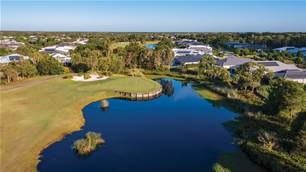
Travel Feature: Golf’s Sunny Side

